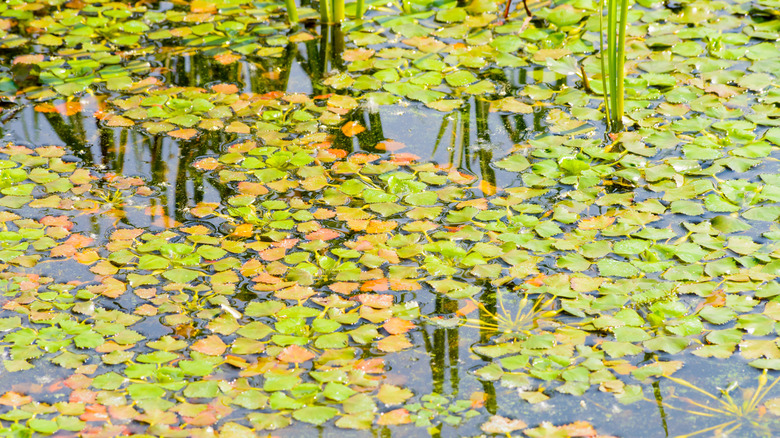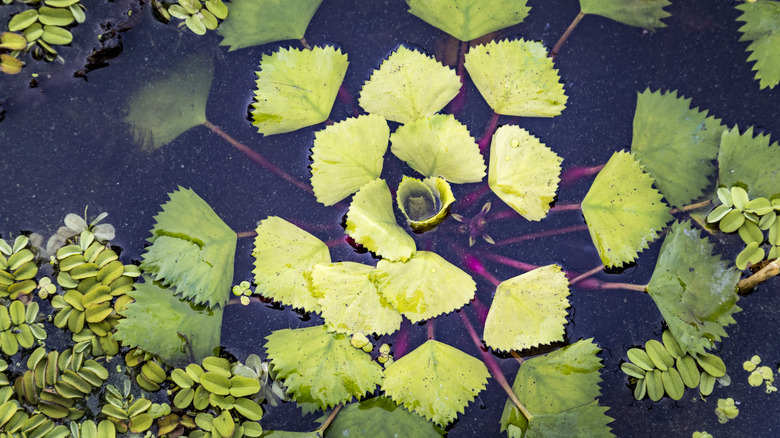The Aquatic Plant That's Illegal To Grow In Several States
The water chestnut or water caltrop, scientifically known as Trapa natans, is an aquatic plant that is native to Europe, Asia, and Africa but has become both common and invasive in the United States. It is an annual plant that grows in freshwater environments such as ponds, lakes, and slow-moving rivers. The water chestnut has a unique appearance with floating leaves that create a rosette pattern on the water's surface. These leaves are triangular and have serrated edges. The annual also produces white flowers that bloom above the water during the summer.
Initially, water chestnuts were introduced to the United States as an ornamental plant. They were first brought to the country in the mid-1800s and quickly spread throughout the Northeast, becoming a major problem for waterways as they compete heavily with native plants and lack a natural predator. In Europe, Asia, and Africa, where the plant originates, a naturally occurring parasite keeps water chestnuts from growing rapidly, but the United States lacks this parasite.
While the water chestnut is an interesting aquatic plant that can add beauty to freshwater environments at first glance, it has turned into a significant issue for many infected states. Since it is difficult to contain once established, the water chestnut has become illegal in some places to protect the existing biodiversity of important waterways.
Why it's illegal in some states
The water chestnut is illegal to grow in several states due to its status as an invasive plant in the U.S. Invasive species are non-native organisms that can spread rapidly and outcompete native species, causing harm to the environment, economy, and human health. The water chestnut is particularly problematic because it forms dense mats of vegetation on the water's surface, which can completely cover and choke out native plants. These mats reduce sunlight penetration, deplete oxygen levels, and alter the habitat for aquatic creatures. This disruption can lead to a decline in biodiversity and negatively impact the overall health of the body of water.
Furthermore, the water chestnut's rapid growth rate and ability to reproduce quickly make it difficult to control once it becomes established. Its floating leaves and rosette pattern provide an ideal platform for the plant to spread and colonize new areas. The plant produces large quantities of seeds that can remain viable for several years, allowing it to persist and spread even if efforts are made to remove it.
To prevent the further spread of this invasive species, multiple states have implemented restrictions on cultivating and selling water chestnuts. These measures aim to protect native ecosystems and prevent the economic and ecological damage caused by the plant's invasive behavior. It is essential for individuals to be aware of the potential harm caused by invasive species and to avoid introducing them into new environments.
How to remove water chestnuts from bodies of water
To manually remove growing water chestnuts from bodies of water, there are several steps you can follow. Before starting the removal process, it is crucial to identify the specific areas where water chestnuts are present. Look for dense mats of vegetation on the water's surface, as this is where the plants are likely to grow. To get started, you will need a few tools. These include a rake or pitchfork, a long-handled net, and a sturdy bucket or container to collect the plants.
Begin the removal process at the edges of the body of water and work your way towards the center. This helps prevent the spread of seeds and minimizes the chances of missing any plants. Use the rake or pitchfork to pull the water chestnuts towards you gently. Be careful not to damage the plants or disturb the sediment at the bottom of the water body. Then, use the long-handled net to scoop them out of the water and place the collected plants in a sturdy bucket or container.
Dispose of the water chestnuts properly to prevent them from re-entering the water. Seal the container tightly and dispose of it in a designated area or compost bin, away from water bodies. Remember: water chestnuts can reproduce quickly, so it may be necessary to repeat the removal process multiple times throughout the growing season to control their spread effectively.

